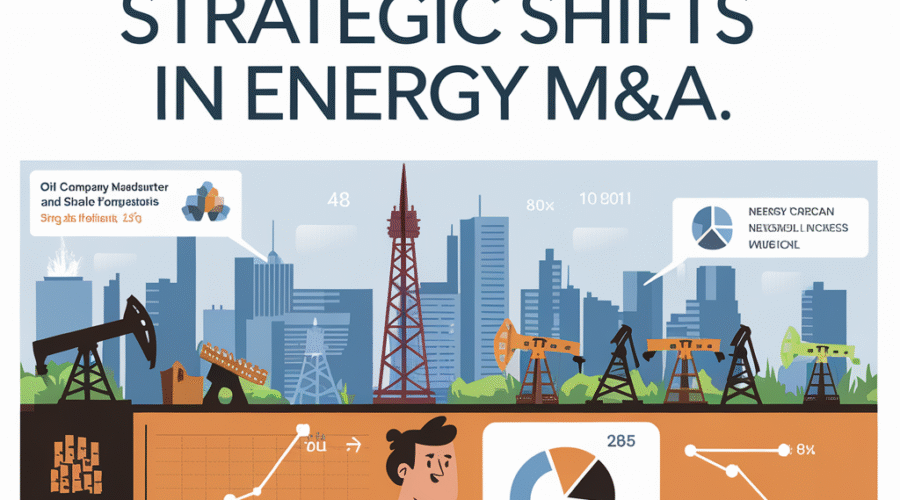The US energy sector faces a pivotal year for mergers and acquisitions as operators grapple with depressed crude prices and dwindling access to high-quality shale assets. According to Enverus Intelligence Research, 2025 will see deal values decline by 30-40% compared to 2024’s $188 billion in public company consolidation, with average transaction sizes shrinking to $500-$800 million as prime inventory becomes scarce[2][5][6]. This recalibration comes amid Brent crude price forecasts of $65-$70/bbl and breakeven economics for acquired assets rising to $50/bbl – a 11% increase from 2022 levels that erodes returns for acquirers[5][7]. While private equity portfolios still hold an estimated $45 billion in remaining shale assets, these largely consist of smaller, higher-cost positions in tier 2-3 basins that require advanced engineering to monetize[2][5].
The New Calculus of Shale Deal Economics
Oil Price Volatility Reshapes Valuation Models
Current Brent crude futures at $68/bbl sit 18% below Enverus’ fundamental fair value estimate of $83/bbl, creating a $15/bbl risk discount that suppresses asset valuations[8]. This disconnect stems from President Trump’s proposed 10% tariff on Chinese imports and weakening OECD demand growth, which the EIA now projects at 0.9 million bpd for 2025 – down 23% from pre-tariff forecasts[3][8]. For acquirers, every $5/bbl price drop reduces the net present value of Permian inventory by 12-15%, forcing reevaluation of deals structured during 2023’s $80/bbl environment[5][7].
Tier 1 Acreage Exhaustion Drives Operational Innovation
With 85% of sub-$50/bbl breakeven inventory now controlled by mega-caps like Exxon and Chevron, remaining opportunities demand technical ingenuity[5]. Enverus data shows 4-mile lateral wells deliver $5/bbl cost advantages over legacy 2-mile designs, making them essential for economic development of marginal positions[5][7]. Pioneer Natural Resources’ recent 23-well test in the Delaware Basin achieved 19% lower drilling costs per lateral foot through automated rigs and zipper frac sequencing – a template acquirers must replicate[7].
Capital Markets Constrain Deal Structures
Debt Financing Costs Limit Leveraged Buyouts
The Federal Reserve’s 5.25% benchmark rate has pushed energy junk bond yields to 9.8%, making traditional LBO models unworkable for most shale deals[4][5]. This financing crunch particularly impacts private equity exits, with Warburg Pincus’ recent sale of Bison Oil & Gas achieving only 5.2x EBITDA versus 6.8x multiples seen in 2023[5]. Creative solutions like royalty interest carve-outs and drillco partnerships now account for 38% of transactions, up from 12% in 2022[6].
Public Company Consolidation Plateaus
After 11 mega-mergers exceeding $2 billion in 2024, the public E&P universe now comprises 22 firms controlling 73% of US shale output[5][6]. With antitrust scrutiny intensifying, remaining consolidation will focus on $500 million-$1 billion bolt-ons – Diamondback Energy’s $740 million acquisition of FireBird Energy exemplifies this trend[5]. Enverus projects public M&A volume will total $45-$55 billion in 2025, down 60% from 2024’s $112 billion peak[2][5].
Engineering Solutions for Marginal Inventory
Extended Reach Drilling Unlocks Stranded Assets
The shift to 3-4 mile laterals reduces per-unit development costs by 18-22%, making previously uneconomic acreage viable at $55/bbl WTI[5][7]. Coterra Energy’s 23-well project in the Marcellus achieved $2.15/Mcf breakevens through 4-mile laterals and centralized sand distribution – a model being replicated in the Haynesville and SCOOP/STACK plays[7]. However, these techniques require $12-$15 million per well upfront investment, straining smaller operators’ liquidity[7].
Artificial Intelligence Optimizes Field Development
Machine learning platforms now enable 92% accuracy in predicting optimal well spacing and completion designs, according to Deloitte analysis[1][6]. ConocoPhillips’ AI-driven reservoir modeling in the Eagle Ford has boosted 180-day cumulative production by 31% while reducing frac hits by 44%[6]. These digital tools are becoming table stakes for acquirers evaluating complex, non-contiguous acreage positions.
Geopolitical Wildcards Alter Risk Profiles
Trade Policy Impacts Midstream Economics
President Trump’s proposed tariffs on steel imports could raise pipeline construction costs by 15-18%, complicating takeaway solutions for acquired assets[8]. The potential 10% levy on Chinese goods also threatens 340,000 bpd of US crude exports, creating basis differential volatility that requires sophisticated hedging strategies[3][8].
OPEC+ Production Strategy Creates Price Floor
Saudi Arabia’s recent commitment to extend 1 million bpd of voluntary cuts through Q3 2025 establishes a $65/bbl Brent floor, according to Enverus models[8]. This policy support enables acquirers to underwrite deals using conservative price decks, with 63% of 2025 transactions incorporating three-year collar hedges on 40-50% of production[5][8].
Conclusion: Adaptation as Strategic Imperative
The shale sector’s next phase demands technical precision and financial discipline. With prime assets largely consolidated, successful acquirers will combine advanced engineering, AI-driven optimization, and innovative deal structures to unlock value from marginal positions. As Enverus notes, the era of “easy M&A” has ended – 2025’s winners will be those who can extract operational excellence from complex reservoirs while navigating an increasingly volatile macroeconomic landscape[2][5][8].
Sources
https://www2.deloitte.com/content/dam/Deloitte/us/Documents/energy-resources/us-er-realizing-value-in-the-shale-m-n-a-market.pdf, https://www.argusmedia.com/en/news-and-insights/latest-market-news/2650711-fewer-smaller-shale-deals-in-2025-enverus, https://www.enverus.com/blog/navigating-oil-price-volatility-amid-trumps-tariffs/, https://thestockmarketnews.com/weak-oil-prices-limited-shale-acreage-to-hit-energy-ma-in-2025-enverus-says/, https://www.hartenergy.com/ep/exclusives/enverus-ma-set-cool-smaller-deals-higher-breakevens-211729, https://www2.deloitte.com/us/en/pages/energy-and-resources/articles/us-shales-ma-activity.html, https://worldoil.com/news/2024/10/1/shale-production-costs-seen-rising-2-8-in-2025-enverus-says/, https://www.worldoil.com/news/2024/12/10/trump-s-return-complicates-oil-and-gas-forecasting-through-2030-enverus-says/





